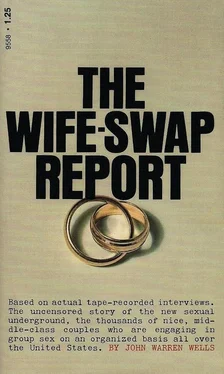John Warren Wells
The Wife-Swap Report
There is a song Pete Seeger sings about little boxes made of ticky-tacky, identical ticky-tacky houses inhabited by identical ticky-tacky people. The Gordon house is a luxury-class version of just this sort of suburban sameness. It is a four-year-old split-level on a half-acre lot in a development in Morris County, New Jersey, within easy commuting range of New York City. The current market value of the house is probably around thirty-five thousand dollars. The house is made of ticky-tacky (several of the windows leak; there are ceiling cracks as the structure settles) and it does look rather like its neighbors on either side, but there is certainly nothing drab about it. On the contrary, it is representative of the good life in affluent, leisure-oriented mid-century America.
The people in the house do not look just the same as their neighbors. On balance, they look quite a bit better. Paul Gordon is thirty-two years old, tall, slender, with brown eyes and straight dark brown hair. While he is not handsome enough to model for menswear advertisements, there is a strength and vitality in his features which borders on the charismatic.
His wife, Sheila, is three years younger and several inches shorter. Her large eyes are green flecked with brown, and her hair, originally a light brown, is presently blond. She is slender almost to the point of thinness, with small breasts and boyish hips. Her face is unusually expressive, quick to indicate her mercurial changes of mood. Her upper incisors are somewhat prominent, her forehead broad and high. By no means beautiful, she is nevertheless strikingly attractive, the sort of woman men find highly desirable while never being able to explain exactly why.
There are three Gordon children, Mark and Lisa and Heidi, ranging in age from nine to four. The children are bright, active and healthy; Mark and Lisa look rather like their mother while Heidi has inherited Paul’s features. The backyard is a mare’s nest of bikes and swing sets, while the basement playroom is largely given over to their toys.
Paul is a systems analyst presently employed by a large corporation with executive offices in Manhattan. His current salary is $16,350, plus the usual array of fringe benefits and pension plans. His work occupies him five days a week from nine in the morning until five in the afternoon, with another two hours a day commuting time. He characterizes himself as “a sort of efficiency expert for computers” and seems happy enough at it. One senses that it is no more than a job, that the compensation and challenge are sufficient to prevent him from feeling bored or trapped, and that the problems of the job rarely if ever occupy his mind while he is away from the office.
Sheila, like her husband, is a college graduate. Twice since graduation she has enrolled at a university to take additional courses toward a master’s degree, but both times she abandoned the project within a month or so. She talks occasionally of going back to college when the children are older, or, alternatively, of qualifying as an elementary school teacher. This seems more lip service to the feminine mystique than anything else, and if Sheila finds the role of wife and housekeeper confining, her reaction is certainly no more than typical for women in her situation, overeducated for an occupation which modern technology has in turn rendered increasingly mechanical and routine. In the main, she is happy with her role — in love with her husband, devoted to her children, secure in her home.
Little boxes on a hillside—
Ten or twenty or thirty times a year, for the past six years, Paul and Sheila Gordon have gotten together with one or more other couples for an evening of organized adultery.
The horror is that there is no horror, that the whole concept of wife-swapping has in the space of little more than a decade become a commonplace article of popular journalism, a staple for sensationalistic magazines and racy newsstand fiction. Consider the simple definition of the practice — married couples have revised their definition of the marital relationship so as to consider the exchange of partners for sexual purposes wholly compatible with the maintenance of these relationships. Such a state of affairs could hardly be less than remarkable.
And yet we scarcely find it remarkable at all. On the contrary, we are rather more likely to accept the existence of wife-swappers much as we accept the existence of electrons — we cannot see them, but we have it on good authority that they exist. We may read about them, being either titillated or enervated or bored according to our inclinations, but our involvement with them is never other than vicarious. They are certainly not the sort of people we are apt to meet on the street.
But this is manifestly not the case.
Over the past several years I have written a number of books and magazine pieces dealing with various aspects of the sexual revolution. The wife-swapping fraternity has featured prominently in my writing and research. And if one fact stands out among all others, it is simply that these swingers, these wife-swappers, are in every sense of the terms the “folks next door.” If there is one striking thing about the practice of swapping, it is the way in which it cuts across all strata of society. And if there is one striking thing about the average couple involved in this pursuit, it is how exceptionally average they are.
If this is the case, why then are wife-swappers universally regarded as a breed apart? The answer is not really that elusive. When a group is considered only in respect to that idiosyncrasy which sets it apart — whether sexual or racial or religious or whatever — the idiosyncrasy overshadows the individuals. It must be consciously borne in mind that while a man may be a homosexual or a Negro or a Mohammedan or a philatelist or a ditch digger, he is never one of these things twenty-four hours a day to the exclusion of all else.
All of which is a roundabout explanation of the genesis of this present book. I began interviewing Paul and Sheila Gordon in connection with another book dealing with various aspects of the contemporary sexual underground. I was struck at once by the special qualities of Paul and Sheila — their intelligence, their perception, and, perhaps most important of all, their ability to verbalize effectively concerning their ideas and experiences. While it is by no means rare to encounter swingers who are willing to talk about their experiences, the vast majority of them are not much good at talking about anything. The Gordons were unusually articulate subjects, and it never ceased to be a pleasure to interview them.
As it turned out, I did not make direct use of these interviews in the book I was then preparing, although the insight which I gained through my contact with Paul and Sheila did enable me to discuss other cases with greater perspective. After the book was completed, however, I found myself frequently thinking of the Gordons and wondering if there might not be some way to make use of their experiences. While musing on the inability of the average “civilian” to appreciate that swingers are the sort of people who might very well move next door to him (and without affecting his property values, either), it occurred to me that a book-length study of one married couple, told almost entirely in their own words, might fill a significant gap. By far the majority of books dealing at all seriously with the wife-swapping phenomenon (as opposed to trashy novels and thinly veiled bits of pornography) employ the anthology approach: i.e., they present perhaps a dozen case histories in order to illuminate many facets of the overall subject.
This is, certainly, a useful approach, presenting the reader as it does with more than a single look at a topic. I can also state from experience that it is very useful for a writer, as it is almost always a simpler matter to select the relevant data about a dozen couples than to mine a book’s worth of material out of a single case history. In this particular instance, however, it seemed to me that a study of a single couple in more than the usual degree of depth was indicated, and that it could prove sufficiently absorbing to sustain a full-length book.
Читать дальше










